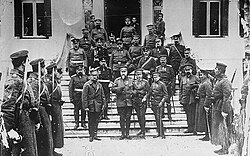 Global Information
Global InformationUnification of Germany information
 States of the German Empire when the Duchy of Saxe-Lauenburg was merged into the Kingdom of Prussia on 1 July 1876 | |
| Native name | Deutsche Einigung |
|---|---|
| Date | 18 August 1866 – 18 January 1871 |
| Location | |
| Participants |
|
| Outcome |
|
| Events leading to World War I |
|---|
 |
|
The unification of Germany (German: Deutsche Einigung, pronounced [ˈdɔʏtʃə ˈʔaɪnɪɡʊŋ] ⓘ) was a process of building the first nation-state for Germans with federal features based on the concept of Lesser Germany (one without Habsburgs' multi-ethnic Austria or its German-speaking part). It commenced on 18 August 1866 with adoption of the North German Confederation Treaty establishing the North German Confederation, initially a military alliance de facto dominated by Prussia which was subsequently deepened through adoption of the North German Constitution.
The process symbolically concluded when most of south German states joined the North German Confederation with the ceremonial proclamation of the German Empire i.e. the German Reich having 25 member states and led by the Kingdom of Prussia of Hohenzollerns on 18 January 1871; the event was later celebrated as the customary date of the German Empire's foundation, although the legally meaningful events relevant to the accomplishment of unification occurred on 1 January 1871 (accession of South German states and constitutional adoption of the name "German Empire") and 4 May 1871 (entry into force of the permanent Constitution of the German Empire).
Despite the legal, administrative, and political disruption caused by the dissolution of the Holy Roman Empire in 1806, the German-speaking people of the old Empire had a common linguistic, cultural, and legal tradition. European liberalism offered an intellectual basis for unification by challenging dynastic and absolutist models of social and political organization; its German manifestation emphasized the importance of tradition, education, and linguistic unity. Economically, the creation of the Prussian Zollverein (customs union) in 1818, and its subsequent expansion to include other states of the Austria (under Austrian Empire)-led German Confederation, reduced competition between and within states. Emerging modes of transportation facilitated business and recreational travel, leading to contact and sometimes conflict between and among German-speakers from throughout Central Europe. The model of diplomatic spheres of influence resulting from the Congress of Vienna in 1814–1815 after the Napoleonic Wars endorsed Austrian dominance in Central Europe through Habsburg leadership of the German Confederation, designed to replace the Holy Roman Empire. The negotiators at Vienna took no account of Prussia's growing strength within and declined to create a second coalition of the German states under Prussia's influence, and so failed to foresee that Prussia (Kingdom of Prussia) would rise to challenge Austria for leadership of the German peoples. This German dualism presented two solutions to the problem of unification: Kleindeutsche Lösung, the small Germany solution (Germany without Austria), or Großdeutsche Lösung, the greater Germany solution (Germany with Austria or its German-speaking part), ultimately settled in favor of the former solution in the Peace of Prague.
Historians debate whether Otto von Bismarck—Minister President of Prussia—had a master plan to expand the North German Confederation of 1866 to include the remaining independent German states into a single entity or simply to expand the power of the Kingdom of Prussia. They conclude that factors in addition to the strength of Bismarck's Realpolitik led a collection of early modern polities to reorganize their political, economic, military, and diplomatic relationships in the 19th century. Reaction to Danish and French nationalism provided for expressions of German unity. Military successes—especially those of Prussia—in three regional wars generated enthusiasm and pride that politicians could harness to promote unification. This experience echoed the memory of mutual accomplishment in the Napoleonic Wars, particularly in the War of Liberation of 1813–1814. By establishing a Germany without multi-ethnic Austria (under Austria-Hungary) or its German-speaking part, the political and administrative unification in 1871 at least temporarily solved the problem of dualism.
Despite undergoing in the later years several further changes of its name and borders, overhauls of its constitutional system, periods of limited sovereignty and interrupted unity of its territory or government, and despite dissolution of its dominant founding federated state, the polity resulting from the unification process continues its existence, surviving until today in its contemporary form known as the Federal Republic of Germany.